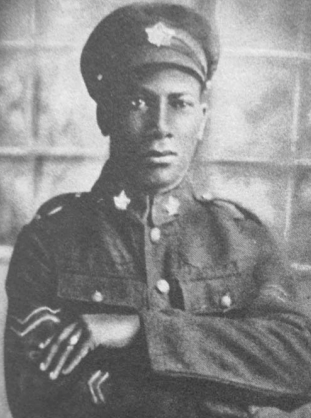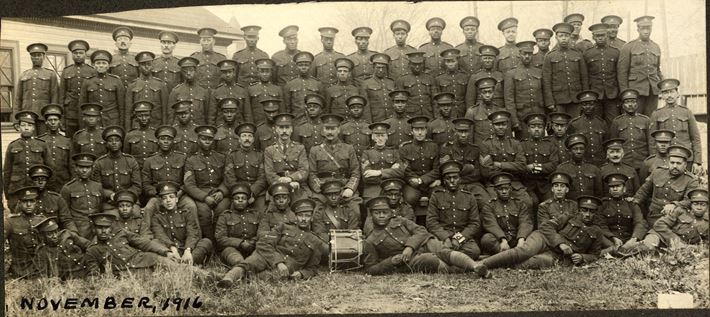Members of the No. 2 Construction Battalion during the First World War [Photo credit: Museum Windsor]
By: Dillon White
When Isaac Phills came to Cape Breton from the West Indies island of St. Vincent, he wanted to farm. But in Cape Breton in 1916, the best bet for work was the Sydney steel plant or the coal mines.
Canada was engaged in the First World War, and Phills, like thousands of other Canadians, decided to enlist in the military. He joined a group of about sixty African-Canadian volunteers in Sydney to enlist.
“It’s a job I’ll like, killing Germans,” said one of the Cape Bretoners in Sydney eager to sign up for the war effort.
Upon offering their services, however, they were told they weren’t wanted.
“In Sydney, after the war started, quite a few Blacks volunteered for active service and were told point blank, ‘We don’t want you, this is a white man’s war’,” Phills said to author and former Canadian senator Calvin Ruck for his book, Canada’s Black Battalion.
In 1915, Alexander Bramah, an African-Canadian miner in Sydney Mines, wrote to a Major-General asking for the “privilege of joining” an east coast battalion.
“I’ll go to do my bit for the flag that I was born under.,” Bramah wrote. “I’ll go out there without any wages.”
Across the country, military leadership rebuffed African-Canadian volunteers.
Dr. Graham Reynolds, a history professor at Cape Breton University and author of Viola Desmond’s Canada says there was deep-seeded racism in Canada during the early 1900s and an effort to keep the country white.
“During the first part of the 20th century, Canada experienced a very heightened sense of racial identity,” Reynolds said. “The general attitude in Canada during that period was that Canada was a white nation, founded for white races and this extended to official policy as well.”
Reynolds says those views were also present in Cape Breton. While the mines were racially integrated, the overall community was more divided.
“There wasn’t so much [segregation] in the mines, but the community at large was very much segregated,” Reynolds said. “There was certainly a tradition of segregation and discrimination in Sydney, Glace Bay and in Cape Breton generally.”
While Canada’s racial attitudes prevented them from fighting in the early years of the war, both Bramah and Phills eventually had the chance to serve.

Isaac Phills
In 1917, the Military Service Act was passed to replace battalions depleted by casualties, and conscription became law. Ironically, the black Cape Bretoners who were refused as volunteers earlier in the war were now being drafted.
“Around 1917, the Canadian army was up against it. They had lost a lot of men in France,” Phills said. “At that point they were willing to take anyone. Conscription came in and then they took Blacks and Whites. You had no choice, you had to go.”
Forty-five soldiers from Sydney, Glace Bay and New Waterford were assigned to the No. 2 Construction Battalion, a segregated unit that served overseas.
Phills was called up in 1918 and received initial training in Aldershot before receiving more in Europe. While training in Canada, soldiers were racially integrated but became segregated upon arrival in England.
“In Canada we experienced no problems. The training and living conditions were on an integrated basis. We trained, ate, and lived together. We sailed for overseas together as Canadian soldiers,” Phills said. “Shortly after England we were taken out of the regular group we had trained with and put by ourselves. We did not ask why, we just followed orders.”
Phills was named Corporal of his unit. While they were trained for combat, the No. 2 Construction Battalion was assigned mainly to performing fatigue duties, loading trucks and labour work.
In Canada’s Black Battalion, Sydney native Calvin Ruck wrote about the challenges the African-Canadian soldiers faced when they returned from the war.
“The Black veterans who were prepared to serve and die in the defence of freedom also came home to many of the same restrictions and oppressions,” Ruck wrote. “The Great War did not end all wars and it did not signal an end to racial prejudice.”
When Isaac Phills returned to Cape Breton, he wasn’t able to take up farming. He continued to work at the Sydney steel plant and lived in Sydney for over 60 years. In 1967, he became the first black man to receive the Order of Canada, earning the award for “outstanding citizenship in terms of providing university and vocational education to his seven children.”
[Sources: Ronald Caplan’s Cape Bretoners in the First World War, Calvin Ruck’s Canada’s Black Battalion, James W. Walker’s Race and Recruitment in World War 1 and Cape Breton Post (2014) “Phills, first black man to be awarded Order of Canada, called Pier home”]





0
Log In or Sign Up to add a comment.- 1
arrow-eseek-eNo items to displayFacebook Comments